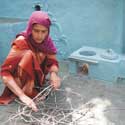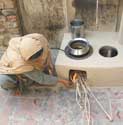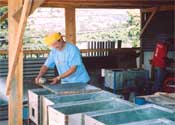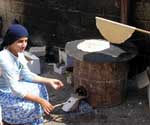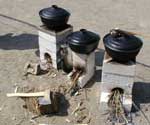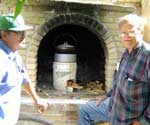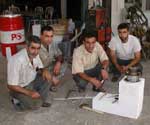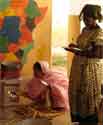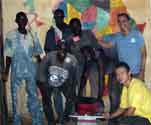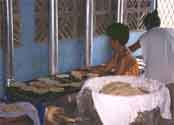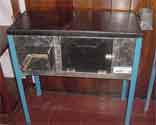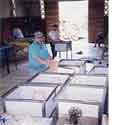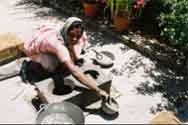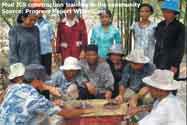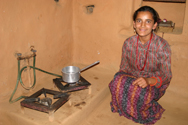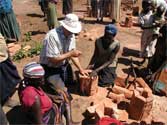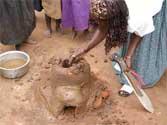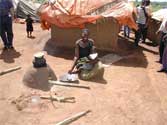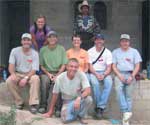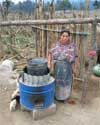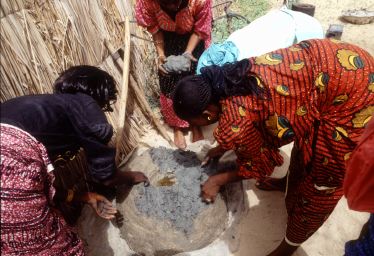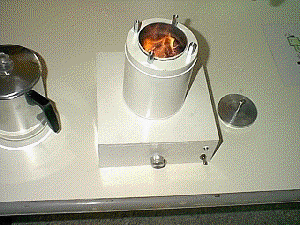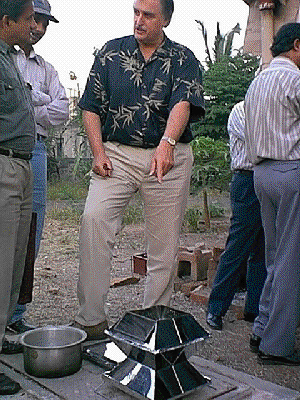Dissemination of Improved Biomass Cooking Stove Designs and Fuel Production
- Escorts "Naada" Stove, Escorts Foundation, Changa Manga, (near Lahore) Pakistan, Maisoon Zamir, 2004 Energy Globe (Austria) Winner, 56 villages, 11758 stoves January 2006
Fuel-Efficient Smokeless Stoves, Pakistan, GEF UNDP Small Grants Programme (SGP)
2004 Ashden Award ARECOP:2002
- HELPS INTERNATIONAL Year-End Status, Don Oneal, HELPS,
December 2005
- Honduras Microenterprise Project
Stuart Conway, Trees, Water and People, December 2005
-
- Duffy Hughes Memorial Stoves Project, Nancy Hughes, Eugene, OR, November 2005
- Institutional Stoves in Southern Africa: Malawi Report 2005, Peter Scott, Aprovecho for GTZ/Probec North, October 2005
- Improved Stoves Project, Rosso, Mauritania Aprovecho/Sunsmiles Training for EPA/Peace Corps. Slide Show By Dr. Mouhsine Serrar, Sunsmiles, Sept 24- Oct 6, 2005
- Honduras Micro-Enterprise Stoves, Patrick Flynn, Trees Water and People, September 2005
- PROLENA - Nicaragua Stoves, Patrick Flynn, Trees Water and People, September 2005
- Partnership for Clean Indoor Air Bulletin: Issue 4, August 2005
- ARECOP Newsletter June/July 2005, Asia Regional Cookstove Program, July 2005
- Ashden Health and Welfare Award: Nepal, Biogas Sector Partnership installs 124,000 household biogas plants, Sundar Bajgain, July 2005
- AID Uganda April-May 2005, 10,000 Stoves Project, Ken Goyer June 2005
- Duffy Hughes Memorial Stoves Team Installs 200 Stoves in Solola, Guatemala, Nancy Hughes, June 2005
- Installation of Improved Metal Cooking Stoves in the Khumbu Region: Field Visit Report (1 of 3) Sustainable Technology Adaptive Research and Implementation Center, Nepal Sjoerd Nienhuys,SNV-Nepal January 2005 (2 of 3) (3 of 3)
- Investing in Ourselves: Giving and Fund Raising in Pakistan, Asian Development Bank, March 2004
- International Seminar on Bioenergy and Rural Sustainable Development Small Scale Applications Working Group Morelia, Michoacán, México, June 27, 2003
- Regional Workshop on Sustainable Improved Cookstove Dissemination with Special Emphasis on Commercialisation. Cebu, Philippines 15-18 February 2003 Organised by : Asia Regional Cookstove Program Secretariat (Indonesia) & APPROTECH Asia (Philippines)
- DISSEMINATION OF IMPROVED COOKSTOVES IN RURAL AREAS OF THE DEVELOPING WORLD: Recommendations for the Eritrea Dissemination of Improved Stoves Program, 2003, by Ayça Ergeneman for Eritrea Energy Research and Training Center (ERTC), Robert Van Buskirk (June 2003) (pdf 1 MB)
- Regional Workshop on Sustainable Improved Cookstove Dissemination with Special Emphasis on Commercialisation. Cebu, Philippines 15-18 February 2003 Organised by : Asia Regional Cookstove Program Secretariat (Indonesia) & APPROTECH Asia (Philippines)
- A commercialization methodology for cookstove dissemination in Southern Africa (Comm_SA, PDF, 32KB) Rina J King BSc(Eng), Margaret Pemberton-Pigott, Crispin Pemberton-Pigott, New Dawn (Pty) Ltd ARECOP February 2003
Microenterprise
Possible Reasons for Success or Failure of Stove Programs
|
Reasons for success
|
Reasons for Failure
|
- Program targets region where traditional fuel and stove are purchased or fuel is hard to collect,
- People cook in environments where smoke causes health problems and is annoying.
- Market surveys are undertaken to assess potential market for improved stoves.
- Stoves are designed according to consumer preferences, including testing under actual use.
- Stoves are designed with assistance from local artisans.
- Local or scrap materials are used in production of the stove, making it relatively inexpensive.
- The production of the stove by artisans or manufacturers is not subsidized.
- Stove or critical components are mass produced.
- Similar to traditional stove.
- The stove is easy to light and accepts different sized wood.
- Power output of stove can be adjusted.
- The government assists only in dissemination, technical advice, and quality control.
- The stove saves fuel, time, and effort.
- Donor or government support extended over at least 5 years and designed to build local institutions and develop local expertise.
- Monitoring and evaluation criteria and responsibilities chosen during planning stages according to specific goals of project.
- Consumer payback of 1 to 3 months.
|
- Program targets region where traditional fuel or stove are not purchased or fuel is easy to collect.
- People cook in the open, and smoke is not really a problem.
- Outside experts determine that improved stoves are required.
- Stove is designed as a technical package in the laboratory, ignoring customers' preferences.
- Local artisans are told or even contracted tobuild stoves according to specifications.
- Imported materials are used in the production of the stove, making it expensive.
- The production of the stove by artisans or manufacturers is subsidized.
- Critical stove components are custom built.
- Dissimilar to traditional stove.
- The stove is difficult to light and requires the use of small pieces of wood.
- Power output cannot be easily controlled.
- The government is involved in production.
- The stove does not live up to promised economy or convenience under real cooking conditions.
- Major achievements expected in less than 3 years, all analysis, planning, and management done by outsiders.
- Monitoring and evaluation needs are not planned and budgeted, or criteria are taken uncritically from other projects or not explicitly addressed.
- Consumer payback of more than 1 year.
|
What Makes People Cook with Improved Biomass Stoves? A Comparative International Review of Stove Programs
Douglas F. Barnes, Keith Openshaw, Kirk R. Smith, and Robert van der Plas, World Bank Technical Paper 242. May 1994, Box 4, p.14 and evaluated by Sjoerd Nienhuys,
SNV, Nepal, in The Beehive Charcoal Briquette Stove in the Khumbu Region, (1 800 kb pdf) March 18, 2003
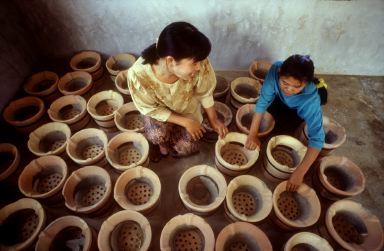 |
|
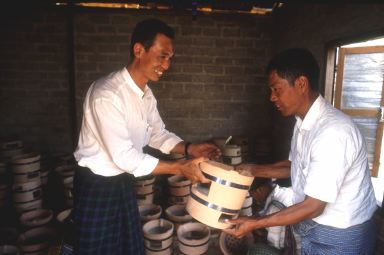 |
 |
|
|
|
|
Mulanje, Southern Malawi: Making portable clay stoves as income
C. Roth /IFSP
|
- National Cookstove Programs (India, Kenya, China)
- Regional Cookstove Programs (RWEDP, GTZ, Enterpriseworks)
- Local Projects (Aprovecho, Helps, Trees Water and People, New Dawn Engineering)
- NGO and Multinational (VITA)
National Cookstove Programs
RON LARSON to AD Karve on Indian national cookstove program: I wonder if you agree that certain aspects of a national stove program could still be important in other countries (as I don't believe it wise to take this particular stove program failure to be the last word). These aspects come to mind:
1. Continuing and serious program evaluation is necessary (maybe by an outside group)? In India it appears there may have been no such evaluation for 17 years?
2. Some testing is probably appropriate - emissions, efficiency, epidemiological results?
3. Subsidies for initial education and promotion of products that have merit - but may be too little known?
4. Stay away from free or heavily subsidized units? (or are there cases when a limited and early-phased-out subsidy is appropriate)
5, Any other appropriate national roles?
AD Karve: Indian Cookstove Program
National Programme on Improved Cookstoves in India was started by the Government of India in 1984. World Bank conducted a survey in 2001 and came to the conclusion that it was failure and recommended that it be terminated. The only success reported in the World Bank Report was the implementation of this programme in some pockets of Maharashtra, where rural artisans trained by ARTI conducted this activity as a commercial activity.
In its survey the World Bank found that the failure of the programme was mainly due to the fact that it was conducted as a target oriented welfare activity, in which the welfare part was ignored and the fulfillment of target was given greater importance. Therefore, in many cases, no improved cookstoves were found in households that were listed by the authorities as having been beneficiaries of this programme. In many cases, the beneficiaries received a portable metallic cookstove, which was fabricated in a central factory and was very easy to distribute. This device was generally kept in the attic and used only occasionally as an additional cooking device. In many cases, the beneficiaries did not get the model (e.g. single pot, without chimney) that they wanted and were forced to accept the more costly two pot model with chimney. As one does not always have two pots simultaneously on the stove, heat from the second pot hole was wasted whenever only one pot was being used. The most damning part of the report was that there was no repeat buying, because the users were not satisfied with the original model received by them.
In the case of the Cookstove programme in Maharashtra state, ARTI acted as the Technical Backup Support Unit of the programme. We trained the artisans, conducted orientation programmes for the government officials involved in the programme, developed cookstoves, conducted efficiency and pollution tests of all the models, conducted test marketing by installing these models in the houses of the beneficiaries and got their feedback, conducted user training programmes, produced publicity material, etc. We used to conduct users' training programmes in about 200 plus villages every year. The villagers would be shown all the models that were approved under the programme, they were told that they had the freedom to select the model, they were also taught how to take care of each model, how to use the fuel, and how much money they have to deposit with the implementing agency in order to get their cookstove. But our efforts were totally in vain, because the programme was implemented by government bureaucrats, for whom this programme had a very low priority. The money for the subsidy came from New Delhi to the Government in Mumbai, but its payment depended upon the progress reports submitted by the Government of Maharashtra to the Central Government. Under this programme, Maharashtra was to install annually about 150,000 improved cookstoves every year.Our financial year ends on 31st March. The State Government would wake up on the 1st of March and insist on the target being fulfilled before 31st of March. The mud cookstoves, which are what the housewives actually wanted, have to be manually cast with the help of a mold, into the kitchen of the beneficiary. But because one potter can at the most install 5 cookstoves in a day, the work used to be very slow. Therefore, in order to complete the target before 31st of March, the bureaucrats just purchased mass produced, portable metallic cookstoves and distributed them, irrespective of the wishes of the people. There was only a single authorised manufacturer of this category of cookstoves. One can easily envisage that he could quote any price he wanted to, and from this inflated price, he could give a cut to the concerned bureaucrats.
Not catering to the wishes of the people was the main reason of the failure of this programme.
The National Programme on Improved Cookstoves, a subsidy driven welfare activity of the government of India was terminated with effect from the year 2002, because it turned out to be a failure.
We just completed a two-day workshop held jointly by ARTI, Government of Maharashtra, Government of India, The World Bank and the Shell Foundation, to chalk out strategies to promote improved biomass based fuels and improved cooking devices through commercialisation mode. A programme, acceptable to all the stake-holders has been chalked out and Shell Foundation has agreed to fund it for the next three years. No direct subsidy would be given either to the improved fuels nor to any of the cooking devices, but money would be made available for propaganda, users' training, manufacturers' training, market research, market development and promotion. We hope that the programme would succeed this time, and if it succeeds in Maharashtra State, it would be duplicated in other states of the country.
A.D.Karve Appropriate Rural Technology Insitute (ARTI) Pune, India.
TB Reed. This is an object lesson to all stovers who want to reach a billion stoves.
1) Don't jump into mass production until you have 100 satisfied customers.
2) Sounds to me like the 2 pot stove would have been acceptable if they had supplied a lid for the second hole (and first while firing up). My wood/coal cooking range in 1955 had lots of lids and concentric rings to fit larger and smaller pots.
AD Karve: It is ARTI, which is guilty of developing the two-pot stove. In the case of the two-pot stove, the flames and flue gases are directed from the first pothole to the second and from there to the chimney. Pots sit flush on the potholes. We get about 60% of the energy at the first pothole and about 40% at the second. We provided this stove both with a lid for the second pot hole and reducer rings to accommodate pots of smaller size, but if the second pothole is not used and is kept closed with a lid, you lose about 40% of the energy, that goes unused through the chimney. In contrast to this, in a single pot stove, you don't lose any energy, because the stove remains unlit if you don't want to put a pot on it. Our single pot stove comes without a chimney. It is extremely popular with housewives, because cleaning the chimney every two months is a big bother. In most cases, nobody bothers to clean the chimney and a cookstove with a choked chimney is worse than a traditional stove. Also the chimney costs almost as much as the stove. Forcing housewives to have a stove with a chimney was a major reason for rejection of the improved cookstoves in India. I have seen that in many houses, because of the resistance on the part of the householders to allow the puncturing of the ceiling of the house, the chimney was allowed to open within the kitchen itself. In this case, the chimney served only to create a nice draft but not as a means of removing pollutants from the kitchen atmosphere.
D. Still:
3.) Learn as you go. Do follow up studies from day one. Check on user satisfaction and improve the stove(s). I'll bet that at least 4 different models would be required to satisfy differing cooking requirements and cooks. Get women involved in decision making.
4.) Education is essential. Folks need to be trained in stove use, wood drying, maintenance, etc. User groups of women, perhaps selling replacement parts as a self subsidy, could visit households with new stoves every three months for the first year. Stoves are used by women, if women help to design, disseminate, improve and fix them then acceptance is more likely.
RESOURCES
